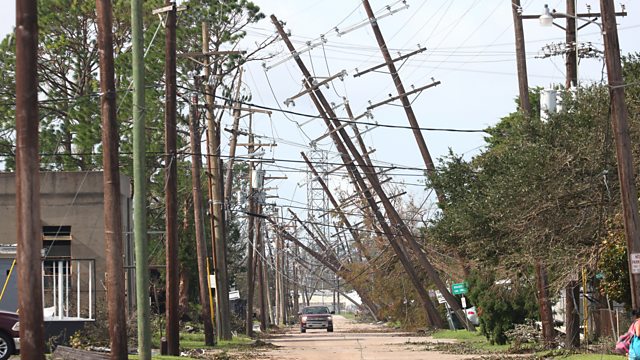
Hurricane season intensifies
Climate change and the havoc caused by Hurricane Ida across parts of the US. Also, the promise of Natural Hydrogen, Chile’s new solar salvation, and ancient Roman diets revealed.
When hurricane Ida struck the coast of Louisiana last weekend, almost to the day that Katrina did 16 years ago, comparisons between the two events were soon to follow. As the latest storm continues to wreak havoc and death further north in the US, Suzana Camargo of Columbia university talks to Roland Pease about the similarities and differences, the better forecasting available now, and the grim reality that climate change suggests for this and future hurricane seasons.
A couple of weeks ago, Science in Action looked at the carbon accounting of Blue Hydrogen (hydrogen manufactured from fossil fuels). Listener Nick Arndt got in touch to say we were wrong when we stated that hydrogen can’t be piped out of the ground from natural sources. His company, Sisprobe, plans to use its passive seismic prospecting technology to work with an international consortium that aims to unlock a new “hydrogen rush” – commercialising what they suspect to be a near-ubiquitous source of genuinely carbon-free fuel - to supply the world economy of the near future. Viacheslav Zgonnik - CEO of start-up Natural Hydrogen Energy LLC - has been working on hydrogen for 10 years, has written a recent review of the science, and tells Roland about current and future studies into finding the best way to tap this simplest of molecules before it escapes into space.
In Chile, the recent megadrought has led to fears that hydroelectric damns may become so drained that power-outs may occur in the coming months. This will not help Chile to achieve its target of carbon-neutrality by 2050. Apt, then, that a new Concentrated Solar Power plant (CSP) is now up and running in the north of the country. Reporter Jane Chambers has been to visit Cerro Dominador – the spectacular new array of 10,600 mirrors that focus sunshine onto a molten salt target, heating it up to 560C, and generating up to 210 MW electricity.
Meanwhile archaeologists have been doing a molecular analysis of a protein found to survive in the bones of unfortunate victims of the mount Vesuvius eruption that destroyed Pompeii. Despite the searing heat that killed inhabitants of nearby Herculaneum, Oliver Criag of York University has been able to examine the different isotopes in amino acids still recoverable from their bones to help identify what sorts of things these people ate during their tragically foreshortened lifetimes. A whole lot of cereals generally, but more interestingly, the men tended to eat more fish while the women seem to have consumed more meat and dairy.
Our connection to the night sky spans cultures and millennia: observing the stars and planets helped our ancestors navigate the world, tell stories about the constellations, and understand our place in the universe. But these days, for the vast majority of us, seeing the stars is getting harder. 80% of people live under light polluted skies, and in many cities you’re lucky to see a handful of stars at night.
This state of affairs is bothering CrowdScience listener and keen stargazer Mo from Salt Lake City in the USA, who wonders if there’s anything we can do about light pollution. Of course, we could simply turn out all the lights, but that’s unrealistic. So what are smarter ways of lighting our communities to preserve our view of the cosmos?
Increasingly worried by the effect of artificial lighting on the ability to observe stars, astronomer Dr Jason Pun set up a series of monitoring stations to continuously measure ‘sky glow’. By comparing sky glow across the world, he wants to figure out which approaches work best.
One community taking an active approach is the South Downs National Park in South East England, one of a number of Dark Sky Reserves around the word. We visit the park and speak to the Dark Skies Officer there, to find out how people are coming together to turn down their lights and keep the night dark.
And it’s not just stargazing that’s threatened by light pollution. Artificial light at night disrupts the circadian rhythms of wildlife. We visit a project in rural Germany looking into the benefits of dark-sky-friendly lighting on insect populations there.
(Image credit: Scott Olson/Getty Images)
Last on
Broadcasts
- Sat 4 Sep 2021 23:06GMT���˿��� World Service South Asia & East Asia only
- Sun 5 Sep 2021 00:06GMT���˿��� World Service except East Asia & South Asia
Podcast
-
![]()
Unexpected Elements
The news you know, the science you don't

